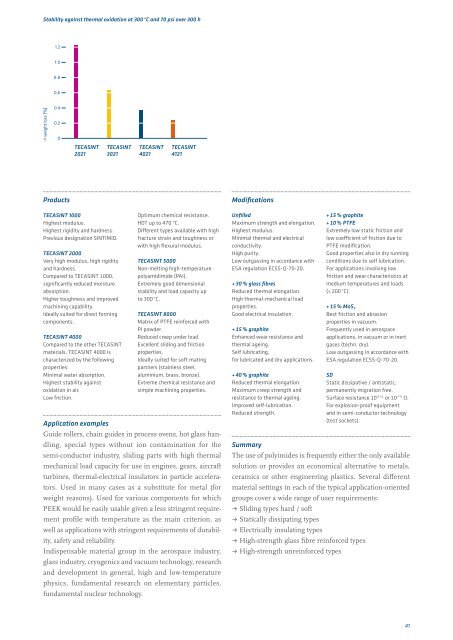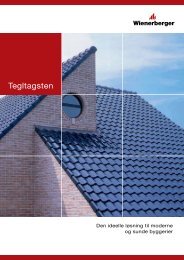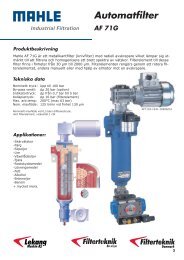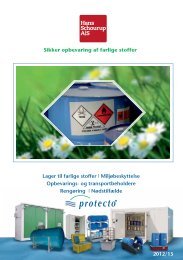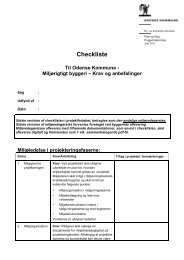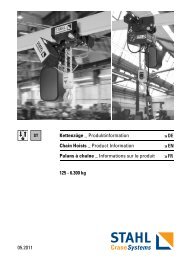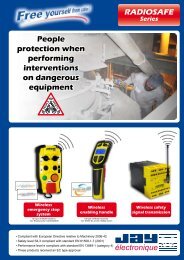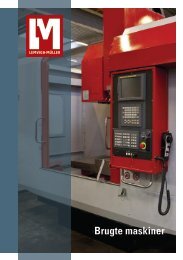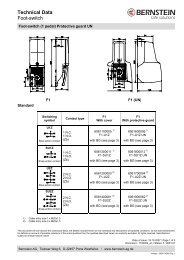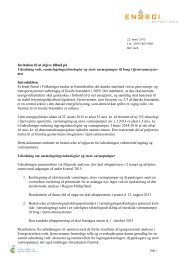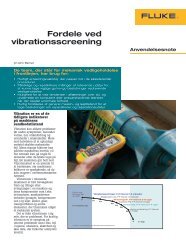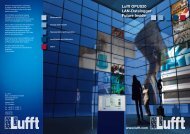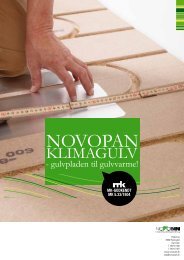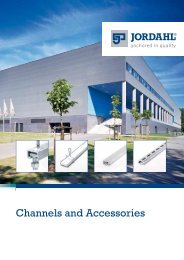Engineering plastics â The Manual - F.wood-supply.dk
Engineering plastics â The Manual - F.wood-supply.dk
Engineering plastics â The Manual - F.wood-supply.dk
Create successful ePaper yourself
Turn your PDF publications into a flip-book with our unique Google optimized e-Paper software.
Stability against thermal oxidation at 300 °C and 70 psi over 300 h<br />
1.2<br />
1.0<br />
0.8<br />
0.6<br />
• weight loss [%]<br />
0.4<br />
0.2<br />
0<br />
TECASINT<br />
2021<br />
TECASINT<br />
3021<br />
TECASINT<br />
4021<br />
TECASINT<br />
4121<br />
Products<br />
TECASINT 1000<br />
Highest modulus.<br />
Highest rigidity and hardness.<br />
Previous designation SINTIMID.<br />
TECASINT 2000<br />
Very high modulus, high rigidity<br />
and hardness.<br />
Compared to TECASINT 1000,<br />
significantly reduced moisture<br />
absorption.<br />
Higher toughness and improved<br />
machining capability.<br />
Ideally suited for direct forming<br />
components.<br />
TECASINT 4000<br />
Compared to the other TECASINT<br />
materials, TECASINT 4000 is<br />
characterized by the following<br />
properties:<br />
Minimal water absorption.<br />
Highest stability against<br />
oxidation in air.<br />
Low friction.<br />
Optimum chemical resistance.<br />
HDT up to 470 °C.<br />
Different types available with high<br />
fracture strain and toughness or<br />
with high flexural modulus.<br />
TECASINT 5000<br />
Non-melting high-temperature<br />
polyamidimide (PAI).<br />
Extremely good dimensional<br />
stability and load capacity up<br />
to 300 °C.<br />
TECASINT 8000<br />
Matrix of PTFE reinforced with<br />
PI powder.<br />
Reduced creep under load.<br />
Excellent sliding and friction<br />
properties.<br />
Ideally suited for soft mating<br />
partners (stainless steel,<br />
aluminium, brass, bronze).<br />
Extreme chemical resistance and<br />
simple machining properties.<br />
Application examples<br />
Guide rollers, chain guides in process ovens, hot glass handling,<br />
special types without ion contamination for the<br />
semi-conductor industry, sliding parts with high thermal<br />
mechanical load capacity for use in engines, gears, aircraft<br />
turbines, thermal-electrical insulators in particle accelerators.<br />
Used in many cases as a substitute for metal (for<br />
weight reasons). Used for various components for which<br />
PEEK would be easily usable given a less stringent requirement<br />
profile with temperature as the main criterion, as<br />
well as applications with stringent requirements of durability,<br />
safety and reliability.<br />
Indispensable material group in the aerospace industry,<br />
glass industry, cryogenics and vacuum technology, research<br />
and development in general, high and low-temperature<br />
physics, fundamental research on elementary particles,<br />
fundamental nuclear technology.<br />
Modifications<br />
Unfilled<br />
Maximum strength and elongation.<br />
Highest modulus.<br />
Minimal thermal and electrical<br />
conductivity.<br />
High purity.<br />
Low outgassing in accordance with<br />
ESA regulation ECSS-Q-70-20.<br />
+ 30 % glass fibres<br />
Reduced thermal elongation.<br />
High thermal-mechanical load<br />
properties.<br />
Good electrical insulation.<br />
+ 15 % graphite<br />
Enhanced wear resistance and<br />
thermal ageing.<br />
Self lubricating,<br />
for lubricated and dry applications.<br />
+ 40 % graphite<br />
Reduced thermal elongation.<br />
Maximum creep strength and<br />
resistance to thermal ageing.<br />
Improved self-lubrication.<br />
Reduced strength.<br />
+ 15 % graphite<br />
+ 10 % PTFE<br />
Extremely low static friction and<br />
low coefficient of friction due to<br />
PTFE modification.<br />
Good properties also in dry running<br />
conditions due to self lubrication.<br />
For applications involving low<br />
friction and wear characteristics at<br />
medium temperatures and loads<br />
(< 200 °C).<br />
+ 15 % MoS 2<br />
Best friction and abrasion<br />
properties in vacuum.<br />
Frequently used in aerospace<br />
applications, in vacuum or in inert<br />
gases (techn. dry).<br />
Low outgassing in accordance with<br />
ESA regulation ECSS-Q-70-20.<br />
SD<br />
Static dissipative / antistatic,<br />
permanently migration free.<br />
Surface resistance 10 9-11 or 10 7-9 Ω.<br />
For explosion-proof equipment<br />
and in semi-conductor technology<br />
(test sockets).<br />
Summary<br />
<strong>The</strong> use of polyimides is frequently either the only available<br />
solution or provides an economical alternative to metals,<br />
ceramics or other engineering <strong>plastics</strong>. Several different<br />
material settings in each of the typical application-oriented<br />
groups cover a wide range of user requirements:<br />
ˌˌSliding types hard / soft<br />
ˌˌStatically dissipating types<br />
ˌˌElectrically insulating types<br />
ˌˌHigh-strength glass fibre reinforced types<br />
ˌˌHigh-strength unreinforced types<br />
41


